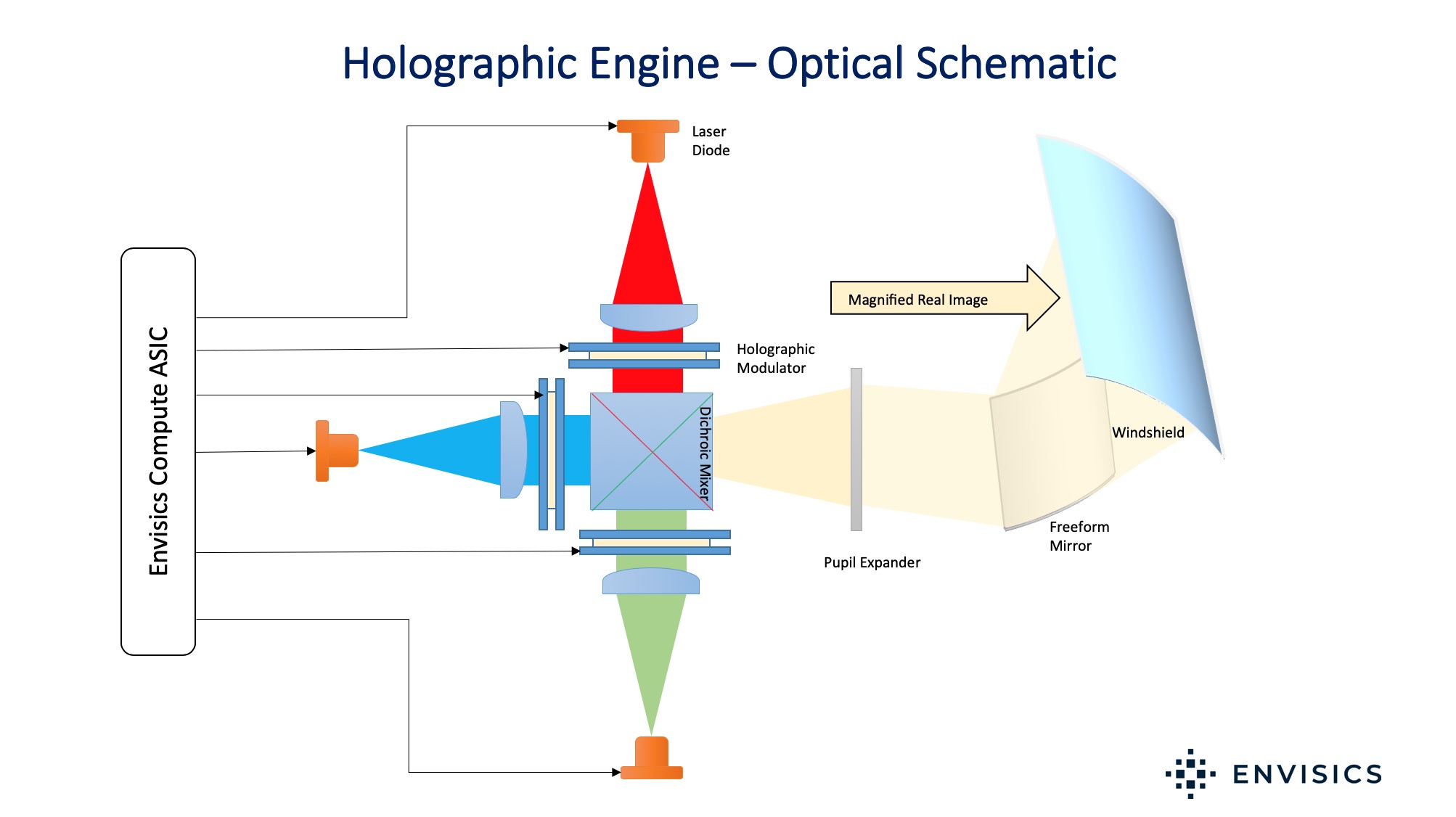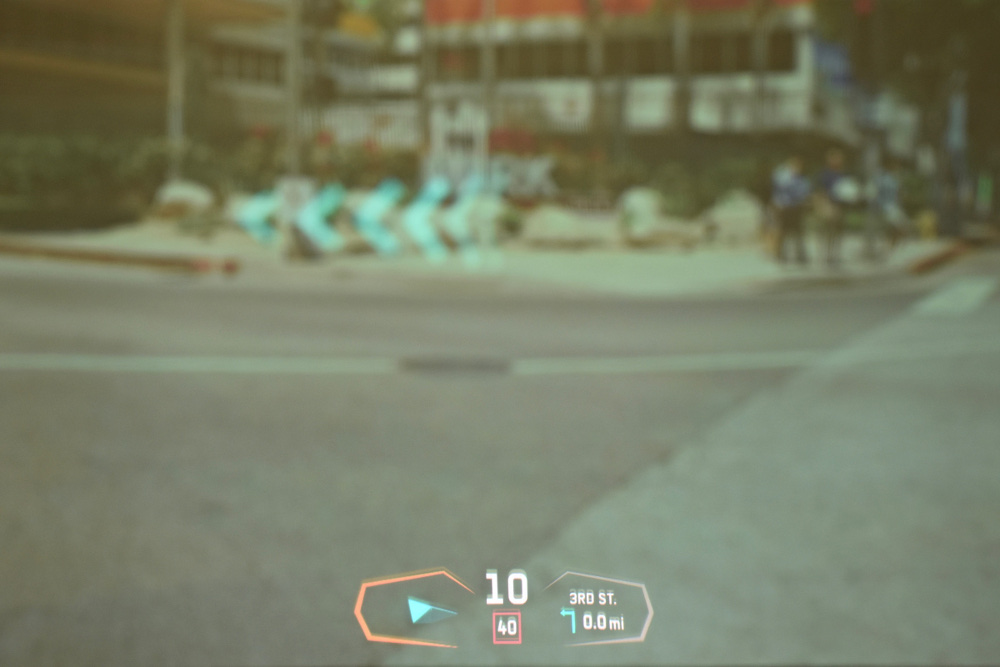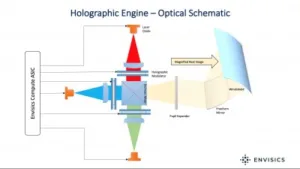After working for a year in stealth mode, holography pioneer and auto head-up display (HUD) developer Envisics showed off their advanced solution at CES 2019. I missed that demo, but the company invited me to their Detroit office to discuss the technology. What I saw was clearly the best auto HUD I have seen to date.

Today, almost all HUDs are image-based. An automotive HUD creates an image on a direct-view or microdisplay and then “projects” the virtual image to a fixed focal plane, typically at the front of the car. The Envisics approach uses a custom developed spatial light modulator (SLM), which is a modified microdisplay, designed to manipulate the phase of light. A hologram of the image you want to display is computed and the hologram pattern is driven to the SLM which is illuminated by a laser or LED.
 Auto HUD schematic – click for higher resolution
Auto HUD schematic – click for higher resolution
The new second approach has the advantage of allowing all the light to be used in displaying content instead of blocking a lot of light as with the image-based approach. The downside can be the heavy computational load needed to calculate the phase hologram.
In our discussion, Envisics CTO Dr. Jamieson Christmas explained that you don’t want to compute the hologram by simply taking the Fourier transform of the image. That creates an amplitude hologram which is optically inefficient and has a large zero-order component – which manifests itself as a bright spot in the middle of the display.
“A phase hologram eliminates this unwanted zero order but comes at the expense of additional computation. Traditional compute methods use a trial and error method to iteratively determine the hologram until you get a good facsimile of the image you want,” explained Dr. Christmas. “But that can’t be done in real time. Part of my Ph.D. was about a new way to do this and is now the basis for our hologram solution. This allows us to dynamically calculate full color high resolution holograms at more than 180 frames per second.”
Dr. Christmas also explained that they have custom developed a silicon backplane of the LCOS for optimized phase modulation. This requires a very high birefringent liquid crystal material to enable accurate phase modulation at full motion video rates.
“These improvements are really critical to optimizing system performance and efficiency,” noted Dr. Christmas.
Spatial light modulators have another significant advantage in manufacturability. The hologram will be visible even if there are many missing pixels on the phase modulator – it just becomes a little less efficient, explained Dr. Christmas. And, alignment is very simple too. From a system point of view, a phase-modulated HUD will be about ½ the size of a more conventional DLP- or LCD-based HUD.
With real time dynamic hologram generation, a whole range of optical functions can be implemented. Symbology like speed, directional arrows and more is of course a necessary component, but one can also implement optical elements, like lenses, as well. What does that mean? It means that the focal plane of the virtual image can be moved in real time. Most importantly, performance trade-off to elements like color, contrast, frame rate, bit depth and more can now be made in software rather than hardware allowing for new features or performance envelopes to be demonstrated quite quickly.
The Gen 2 HUD that Envisics is showing the automotive industry implements a two-plane solution at 2.5m and 10m depth. In terms of resolution, it is much better to talk about pixels-per-degree. Envisics offers 350 pixels-per-degree for the near image plane and 170 pixels-per-degree for the far image plane. To benchmark this, 20/20 vision is roughly 60 pixels-per-degree, so we are talking very high-fidelity images. Brightness can vary from 1 cd/m² to 25K cd/m². Dr. Christmas did not specify the field of view but said they can cover ‘three highway lanes’ with images.
In the Envisics demo, a projector shows a driving video on a screen placed at 10m from the HUD. As the car drives along, we see directional arrows pop up along with broad illuminated patches that highlight the route. These patches move in the HUD field of view (FOV) as the car turns. There are lane-keeping lines, warning signals for a cyclist and other AR cues.
These cues appear to be mapped to the physical world and far-field images do not look like they are placed at a specific distance from the viewer. The image generation takes advantage of longer distance 3D depth cues like geometry to fool the brain into thinking we are looking at a continuous depth space.
The images below show that you can focus on the near field symbology with the background now out of focus, or, focus on the far field image with the foreground out of focus – just like in real life.


One thing that was distracting for me in the demo was some ghosting in the images. For example, one circular icon was quite ghosted when it appeared in the lower part of the field of view, but it quickly converged as it moved higher up in the FOV. The ghost image was only present because the windshield was not optimized for the large field of view in the head up display demonstrator; it is something that could be easily addressed for the production variant, we were told.
I also thought the red colors looked a bit dim. Interestingly, Dr. Christmas said that others have thought it too bright suggesting some human factors issues may be at work here. For example, every person’s photopic response is different so the choice of laser wavelength will affect people differently.
Overall, this was a very impressive demo and Dr. Christmas hinted that Envisics is working with a number of automotive manufacturers and suppliers to develop and deploy this technology in new vehicles and that there are even more advanced versions in development. It is usually a long time from such demos to implementation in a real car but given previous track record with a previous auto HUD company, maybe we can be hopeful such technology will be here sooner than you think. (CC)

